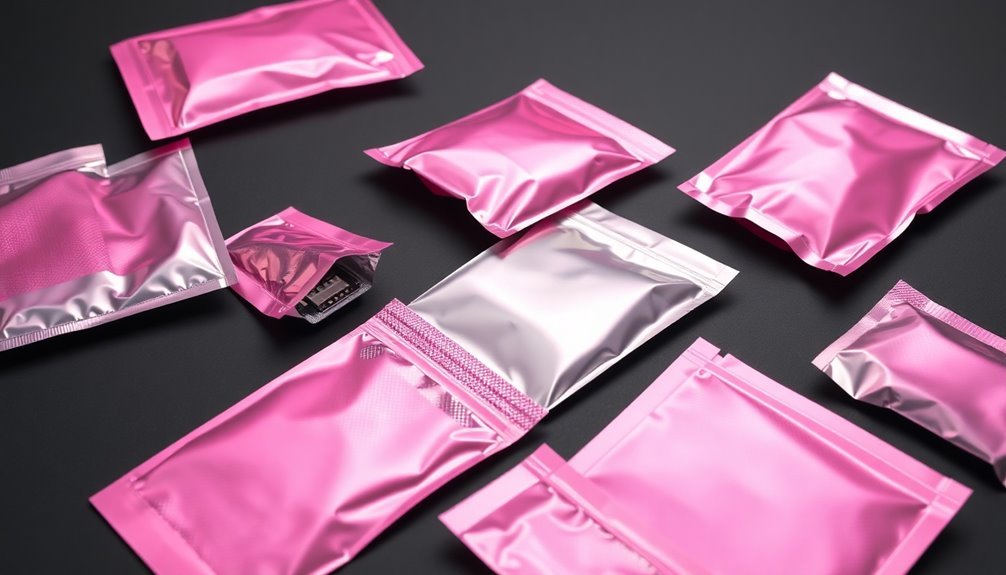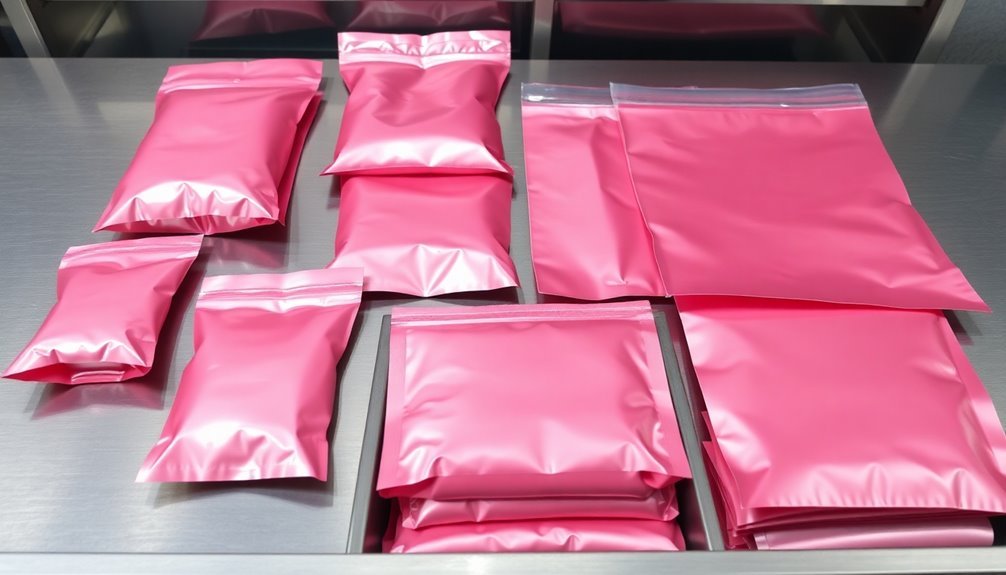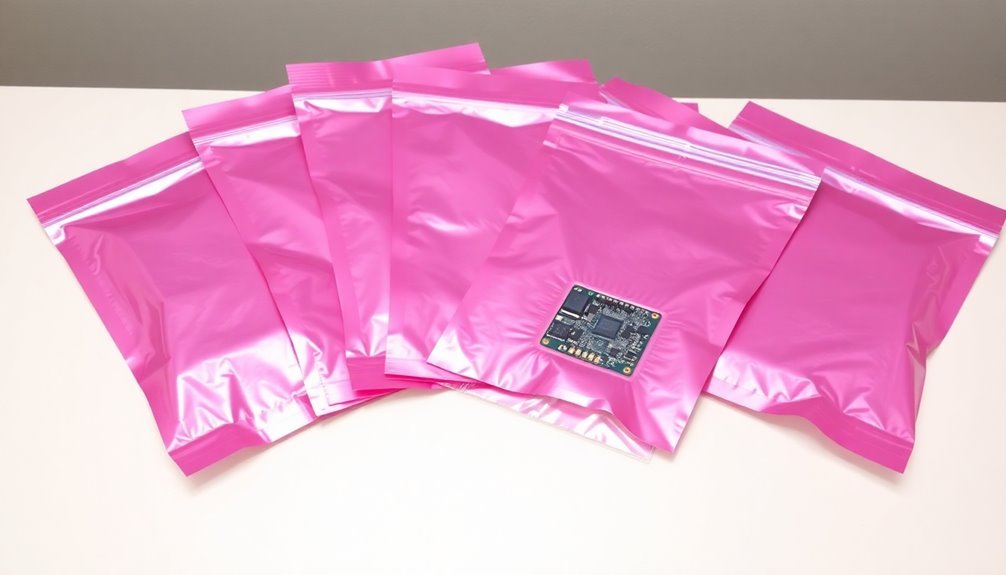Metallized static shielding bags provide your electronics with the highest level of protection against electrostatic discharge. You'll want to avoid basic pink poly bags, as their protective coating can wear off over time. Instead, choose metallized bags that create a Faraday cage effect and comply with ANSI/ESD S541 standards, keeping discharge below 20 nanojoules. These bags combine metalized polyester with low-charging polyethylene for superior protection during storage and transport. While they cost more upfront, their durability and reliable protection make them a smart investment. Understanding the key features of anti-static protection can help you make an informed choice for your valuable components.
Understanding Anti-Static Bag Types

The world of anti-static bags primarily consists of two main types: pink poly bags and metallized static shielding bags.
While both serve to protect electronic components, they offer notably different levels of protection and reliability.
Pink poly bags are made from polyethylene with an antistatic coating, but you'll need to be cautious with these. Their protective coating can wear off over time, making them potentially insulative.
They're also non-compliant with ANSI/ESD S541 standards and can allow tribocharging, which puts your electronics at risk of ESD damage. Regular assessments of packaging effectiveness can help prevent ESD-related component failures.
You'll find much better protection with metallized static shielding bags. These bags combine metalized polyester film with low-charging polyethylene laminate to create a Faraday cage effect. These bags are available in varying thickness ranges from 2 to 6 mil for different protection needs.
They're fully compliant with ANSI/ESD S541 recommendations and maintain their protective properties longer than pink poly alternatives.
When you're choosing between the two, consider that proper ESD protection requires bags to keep discharge levels below 20 nanojules.
Metallized bags consistently meet this requirement through their superior construction and lasting protection, making them the more reliable choice for safeguarding your sensitive electronic components.
Vital ESD Protection Features
Building on our understanding of anti-static bag types, let's examine what makes these protective containers truly effective against ESD damage. The Faraday Cage effect stands as the most important feature in high-end anti-static bags, created by metalized layers that shield sensitive electronics from harmful static discharge.
You'll find this protective mechanism in static-shielding and conductive bags, but not in basic anti-static poly bags. These specialized bags come in varying dimensions to accommodate different electronic components. Many organizations rely on metal-in bags as their standard choice due to cost-effectiveness and reliable protection.
Material construction plays a significant role in determining a bag's protective capabilities. Whether you're working with polyethylene plastic, dissipative polyester, or conductive copolymer, each material serves specific protection needs.
When selecting an anti-static bag, consider these essential features:
- Protection Level – Static-shielding and conductive bags offer protection in both ESD and non-ESD environments, while basic anti-static bags work only in ESD-safe areas.
- Construction Quality – Bags must meet MIL-PRF-81705D and ANSI/ESD S.20.20 standards for reliable protection.
- Physical Integrity – Any damage to the bag's surface compromises its protective properties, so thickness and puncture resistance are key factors.
Remember that proper handling and transportation methods remain essential for maintaining the effectiveness of these protective features.
Top Five Anti-Static Bags

Looking for the most reliable protection for your sensitive electronics? You'll find that metallized static shielding bags stand out as your top choice, offering superior ESD protection through their metalized polyester construction and Faraday cage properties.
These bags comply with ANSI/ESD S541 standards and provide less than 20 nanojoules of discharge. These bags require proper storage conditions to maintain their protective qualities over time. The bags feature seamless tubing design that helps prevent potential tears during handling.
For thorough protection, you'll want to keep in mind shielding bags that meet ANSI/ESD S20.20 requirements. These bags feature heat-sealable options and effectively protect components during all production phases.
Your third option is the standard ESD bag, which provides reliable static protection while meeting ANSI/ESD S11.31 testing standards.
Anti-static bags with amine-free construction rank fourth, offering specialized protection for computer chips and sensitive electronic components.
While pink poly bags are commonly available, they're your fifth and least recommended choice. Their antistatic coating wears off over time, making them non-compliant with current industry standards.
For ideal protection, you'll want to stick with metallized shielding or standard ESD bags that maintain their protective properties throughout their lifetime and meet all current industry requirements.
Moisture Protection Requirements
When protecting sensitive electronics, you'll need to factor in both static discharge and moisture protection requirements. Not all anti-static bags offer adequate moisture protection, so it's essential to select packaging that meets your specific needs.
Multi-layer shielding pouches and moisture barrier vacuum bags provide the most thorough protection for moisture-sensitive electronics. These specialized bags have been in use since 1983 for protecting critical components. Moisture Barrier Bags starting at 3.6Mil thickness deliver professional-grade protection for sensitive items.
For ideal moisture protection, you'll want to take into account these key factors:
- Choose bags with specialized moisture barrier materials and multi-layer construction if you're storing or shipping humidity-sensitive components.
- Look for features like ziplock closures and square bottoms that create better moisture seals.
- Select moisture barrier vacuum bags when you need maximum protection against both static and humidity.
While standard metallized static shielding bags excel at ESD protection, they don't specifically address moisture concerns.
If you're handling components that require both static and moisture protection, you'll need to verify that your packaging complies with ANSI/ESD S20.20 standards and includes proper moisture barrier properties.
Remember that ESD bubble wrap bags might provide physical protection, but their moisture resistance isn't guaranteed unless explicitly stated in their specifications.
Size and Storage Considerations

You'll need to carefully match your ESD bag size to your electronic components, ensuring there's just enough room to insert and remove items without excess space that could lead to shifting during transport.
For efficient storage management, organize your ESD bags by size categories (from 3×5 inches up to 12×15 inches) in moisture-controlled storage areas using clearly labeled bins or drawers.
When storing multiple bags, you can stack them flat or arrange them vertically, but always keep them away from heat sources and direct sunlight to maintain their protective properties.
Proper Sizing For Components
Proper sizing stands at the forefront of effective electronics protection in anti-static storage. You'll want to select bags that are slightly larger than your components to prevent any scratching or damage during insertion and removal.
When handling printed circuit boards, choose bags with flat surfaces that accommodate the board's dimensions while accounting for any protruding elements.
To guarantee ideal protection for your electronic components, follow these essential sizing guidelines:
- Measure all dimensions of your component, including height, width, and any protruding parts, then add a small allowance for easy insertion and removal.
- Take into account batch variations when ordering multiple bags, as component sizes may differ slightly within manufacturing tolerances.
- Select bags that provide enough room for proper sealing while maintaining full ESD protection.
Remember that proper sizing isn't just about fit – it's about protection.
You'll need to take into account the thickness of your bags alongside their dimensions. For standard components, 2 Mil bags often suffice, while more sensitive or bulky items might require 4 or 6 Mil options.
Always guarantee your chosen size allows for easy handling without compromising the bag's protective properties.
Space-Efficient Storage Solutions
From warehouse shelves to workbenches, efficient storage of electronic components requires careful consideration of both space utilization and protection needs. You'll find various size options, from standard 6 x 8 inch bags to custom dimensions that perfectly fit your specific components. When choosing storage solutions, consider both the physical dimensions and the protection level needed.
| Bag Type | Space Efficiency | Best Use Case |
|---|---|---|
| Ziplock ESD | High – Self-sealing | Frequent access items |
| Square Bottom | Maximum – Stable base | Bulky components |
| Bubble Wrap ESD | Medium – Extra padding | Delicate electronics |
| Heat Sealable | High – Compact seal | Long-term storage |
| Moisture Barrier | High – Vacuum capable | Moisture-sensitive items |
You'll want to select bags with appropriate thickness levels, typically 3.5 or 4 mil, to guarantee adequate protection without wasting space. For ideal storage efficiency, consider using stackable bags with reinforced seams. Multi-layered bags offer enhanced protection while maintaining space efficiency, and reusable options can help reduce storage costs over time. If you're storing multiple components, look for bags with tamper-evident features to maintain security during storage and transport.
Industry Standards for ESD Bags
Electronic manufacturers and suppliers consistently rely on established industry standards to guarantee proper ESD (electrostatic discharge) protection. The ESD Association (ESDA) and International Electrotechnical Commission (IEC) set these vital standards, with ANSI/ESD S11.4 and IEC 61340-5-1 being the primary guidelines for static control bags.
When you're selecting anti-static bags for your electronics, you'll need to verify they meet these key standards:
- ANSI/ESD S541 – This standard defines the performance requirements for packaging materials used to protect ESD-sensitive items, including specific testing methods and acceptable resistance ranges.
- ANSI/ESD S20.20 – It provides thorough guidelines for developing an ESD control program, which includes proper usage and handling of anti-static bags.
- IEC 61340 Series – These international standards cover all aspects of electrostatics and ESD control, verifying your chosen bags meet global requirements.
Testing methods like ANSI/ESDA/JEDEC JS-001 and ASTM-257 verify that bags meet these standards through rigorous evaluation of their static dissipative properties and DC resistance.
You'll find that bags meeting these standards offer reliable protection for your sensitive electronic components during storage and transportation.
Common Anti-Static Bag Applications

Anti-static bags serve a wide range of essential applications across multiple industries, with their primary role being the protection of sensitive electronic components from ESD damage.
You'll find these protective bags most commonly used in electronics manufacturing facilities, where they safeguard components like circuit boards, memory chips, and integrated circuits throughout the assembly process.
In storage and transportation, you'll need anti-static bags to protect computer components such as CPUs and GPUs during shipping and warehousing.
They're particularly vital in repair centers and maintenance facilities, where technicians handle sensitive electronics regularly.
If you're working in research and development, you'll rely on these bags to protect prototype components during testing and evaluation.
You'll encounter specific applications across various sectors, from aerospace and defense to medical electronics.
In automotive manufacturing, these bags protect electronic components destined for vehicle assembly.
For cleanroom environments, they're essential in maintaining both static-free and sterile conditions.
Whether you're storing components long-term in a warehouse or conducting quality control inspections, anti-static bags provide the necessary ESD protection to prevent costly damage to sensitive electronic equipment.
Cost Versus Protection Analysis
When balancing your ESD protection needs against budget constraints, you'll need to weigh several key factors. While Metallized Static Shielding Bags come with a higher upfront cost, their superior protection and longevity often make them more cost-effective in the long run. They create a reliable Faraday cage that meets ANSI/ESD S541 standards, protecting your valuable electronics from potentially devastating static discharge.
You'll want to evaluate these critical cost-protection aspects:
- Protection Level vs. Risk – Metallized bags provide less than 20 nanojoules of remaining discharge, while Pink Poly bags can become non-compliant over time, putting your components at risk of expensive damage.
- Long-term Value – Though initially more expensive, metallized bags' durable construction means you won't need frequent replacements like you'd with Pink Poly alternatives.
- Bulk Purchasing Benefits – You can greatly reduce per-unit costs by buying high-quality metallized bags in bulk from established distributors.
When you factor in potential component damage costs and replacement frequency, investing in proper metallized static shielding bags typically proves more economical than choosing cheaper alternatives that offer less reliable protection.
Proper Usage and Handling

Proper handling of anti-static bags calls for strict adherence to ESD safety protocols.
You'll need to store them in areas with controlled temperature and humidity to prevent moisture damage. When handling these bags, you must ground yourself using anti-static wrist straps or gloves to prevent static discharge that could harm sensitive components.
You should inspect your anti-static bags regularly for tears, wear, or damage. If you find any compromised bags, replace them immediately with ones that meet current ANSI/ESD standards.
Don't touch the contents directly; instead, use ESD-safe tools and materials during packaging and handling. When you're working with the bags, minimize movement and friction to prevent static buildup.
For the most effective protection, you'll want to guarantee proper sealing of the bags. If you're handling highly sensitive electronics, use Static Shielding bags with their Faraday cage effect rather than basic anti-static bags.
When additional physical protection is needed, opt for ESD bubble wrap bags. Remember to maintain the bags' protective function by following proper storage procedures and handling them in controlled environments where static risks are minimized.
Frequently Asked Questions
Can Anti-Static Bags Be Safely Reused After Opening?
You shouldn't reuse anti-static bags because they lose their protective properties after opening. Their anti-static coating degrades, moisture absorption increases, and physical damage can occur, putting your electronic components at risk of static damage.
How Long Do Anti-Static Bags Maintain Their Protective Properties?
You'll find metallized shielding bags maintain protection indefinitely, while pink poly bags lose effectiveness over time. It's best to regularly test your bags and replace them when they don't meet ANSI/ESD S541 standards.
Are Colored Anti-Static Bags as Effective as Metallic Ones?
No, colored anti-static bags aren't as effective as metallic ones. Your colored bags rely on coatings that wear off over time, while metallic bags provide consistent Faraday cage protection throughout their lifespan.
What Happens if You Accidentally Wash an Anti-Static Bag?
If you accidentally wash an anti-static bag, you'll damage its protective coating and compromise its shielding properties. You'll need to replace it, as washing ruins its ability to protect against electrostatic discharge.
Can Regular Plastic Bags Be Converted Into Anti-Static Bags?
No, you can't convert regular plastic bags into anti-static bags. They lack the necessary specialized materials like metallized polyester and antistatic coatings needed to create a Faraday cage effect for ESD protection.
In Summary
When you're storing or shipping sensitive electronics, choosing the right anti-static bag is essential. Make sure you select bags that meet industry ESD standards, offer adequate moisture protection, and fit your components properly. Don't compromise on quality to save money – the cost of damaged electronics far outweighs the price of reliable protection. Store your bags in a controlled environment and always handle them with proper ESD precautions.





Leave a Reply